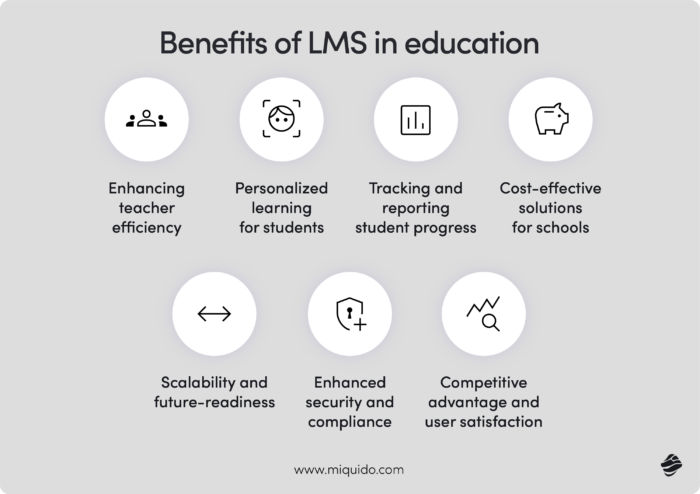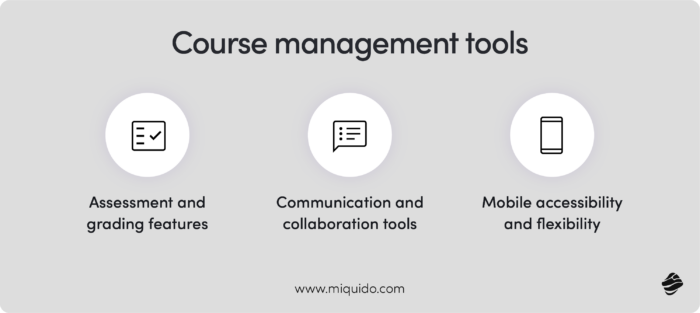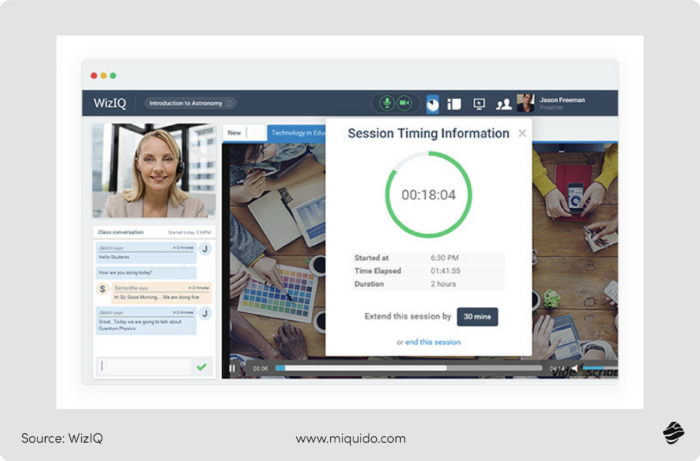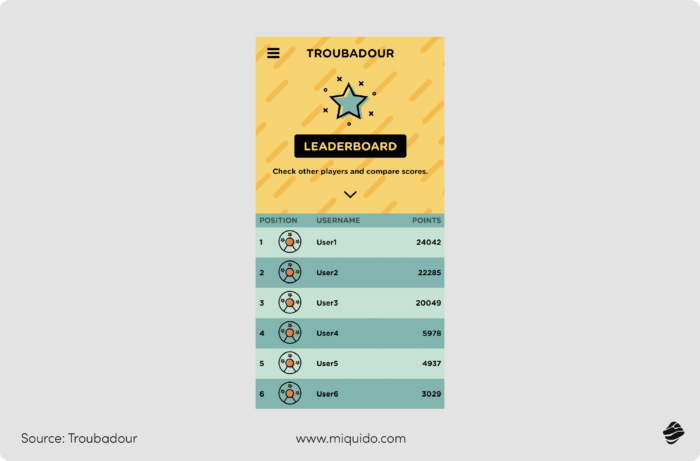With the global e-learning market expected to reach $375 billion by 2026, the demand for digital learning solutions is at an all-time high. Over 83% of organizations now use an LMS, while 73% of U.S. school districts have integrated one into their educational framework. The shift towards digital learning isn’t just a trend—it’s a necessity.
Managing learning resources efficiently has never been more critical. From lesson planning to student progress tracking, educators and organizations face increasing challenges in delivering effective instruction. This is where Learning Management Systems (LMS) step in, providing centralized, interactive, and scalable platforms for education and corporate training.
At Miquido, we have been helping education companies for years, leveraging our expertise to create custom education software tailored to diverse user needs. We specialize in designing intuitive, scalable, and efficient learning platforms. Our experience in education software development ensures seamless integration, robust infrastructure, and solutions that enhance both teaching and learning experiences.
In this article, we will explore LMS’s essence, its impact on education, key features, and future trends. Whether you are an educational institution, a corporate entity, or an individual looking to optimize learning, this resource will provide valuable insights into leveraging LMS for enhanced learning outcomes.
What is a Learning Management System – LMS?
A Learning Management System is a digital platform designed to facilitate the management, delivery, and tracking of educational courses and training programs. It is a centralized hub for educators, administrators, and learners, enabling seamless access to instructional materials, assessments, and communication tools. LMS software is widely used in educational institutions, corporate training, and professional development programs.
Core purpose of an LMS in education
The primary goal of a learning management system is to enhance the learning experience by providing a structured, efficient, and interactive learning environment. LMS platforms empower educators with content management systems, adaptive learning paths, and other educational tools to streamline course delivery and improve student engagement.
Additionally, LMS solutions offer advanced analytics to monitor learner progress and optimize instructional methods. Many modern LMS platforms also incorporate AI knowledge base solutions, enabling institutions to build intelligent repositories of educational content that support self-paced learning, automated assistance, and seamless information retrieval.
Benefits of LMS in education
An LMS improves student engagement through various mechanisms that create a more interactive, personalized, and flexible learning environment. By offering adaptive learning paths, multimedia content, and collaborative tools, students can actively participate in their education, enhancing comprehension and retention.
At the same time, educators benefit from automation and analytics, allowing them to focus on teaching rather than administrative tasks. Implementing an LMS enables institutions to streamline operations, ensure compliance, and scale effortlessly to meet evolving educational demands. Below are the key advantages of an LMS in education.

Enhancing teacher efficiency
Modern LMS solutions streamline daily operations by automating repetitive tasks such as student data handling, resource management, and assessment grading. Precise mapping of teaching and administrative workflows eliminates bottlenecks, enabling educators to focus on instructional quality rather than administrative burdens. Seamless integration with existing tools ensures that teachers have a cohesive, easy-to-use system that enhances productivity.
Personalized learning for students
With adaptive learning capabilities, students can follow customized learning paths that align with their individual progress and needs. The integration of interactive digital tools, multimedia content, and discussion forums creates an engaging and dynamic learning experience. LMS platforms scale effortlessly, ensuring they remain effective as institutions grow and student numbers increase.
Tracking and reporting student progress
Advanced analytics and real-time assessment features provide educators with precise insights into student performance. By integrating multiple data sources, LMS solutions offer structured reports that help instructors identify learning gaps, personalize interventions, and support informed decision-making. Automation in data collection reduces manual effort, ensuring accuracy and efficiency.
Cost-effective solutions for schools
By automating administrative processes and integrating existing systems, LMS platforms reduce operational costs, minimize human errors, and enhance overall efficiency. Digital learning resources replace expensive physical materials, while online and blended learning models lower infrastructure and training expenses. Scalable and flexible architectures ensure institutions can expand their offerings without costly system overhauls.
Scalability and future-readiness
Educational institutions face dynamic changes, from increasing student enrollment to expanding functionalities. Our LMS solutions are designed for flexibility, allowing seamless integration with new technologies and APIs. As organizations grow, the system adapts effortlessly, eliminating the need for costly redevelopment and ensuring long-term sustainability.
Enhanced security and compliance
LMS solutions are built with the latest security standards, safeguarding sensitive student and institutional data. Compliance with regulatory frameworks such as RODO ensures data protection, mitigating the risk of financial penalties. Operational stability minimizes downtime, guaranteeing continuous learning without disruptions.
Competitive advantage and user satisfaction
A future-ready LMS enhances operational performance, improves service quality, and provides a seamless experience for both educators and students. By reducing manual work and optimizing workflows, institutions can focus on strategic growth while ensuring user satisfaction. The implementation of innovative, efficient, and scalable technology gives educational organizations a competitive edge in the evolving digital landscape.
Course management tools
A robust LMS provides essential features for creating, organizing, and managing online courses. It allows instructors to upload instructional materials, schedule lessons, and set up compliance training programs.

Assessment and grading features
Assessment features such as quizzes, assignments, and automated grading systems ensure a seamless evaluation process. LMS platforms also support peer assessments and feedback mechanisms to enhance the learning process.
Advanced analytics provide real-time insights into student performance, allowing educators to identify learning gaps and tailor their instruction accordingly. Additionally, integration with plagiarism detection tools ensures academic integrity and maintains assessment quality.
Communication and collaboration tools
Built-in discussion boards, chat functions, and social learning capabilities enable interaction between students and instructors. These communication tools promote resource-sharing and collaborative learning experiences.
LMS platforms foster community, encouraging active participation and improving engagement and knowledge retention. Features like video conferencing and group workspaces enhance remote learning, making education more interactive and inclusive.
Mobile accessibility and flexibility
LMS solutions are designed to be accessible across mobile devices, allowing users (usually students and tutors) to access resources anytime and anywhere.
A user-friendly interface ensures learners can navigate the system effortlessly, making the educational journey more convenient and effective. Push notifications and offline access capabilities help students stay updated on coursework, deadlines, and announcements even when they are on the move. This level of accessibility empowers learners with greater control over their education, accommodating diverse schedules and learning preferences.
How LMS transforms modern education
The impact of Learning Management Systems (LMS) on education is evident in platforms like Brainly, a global learning community that connects students with expert knowledge and peer support.

By leveraging AI-driven solutions and collaborative tools, Brainly enhances student engagement, streamlines access to educational resources, and fosters interactive learning experiences.
This case exemplifies how LMS platforms revolutionize education by making learning more accessible, personalized, and engaging. Below are key ways in which an LMS transforms modern education.
Facilitating remote and hybrid learning
With the rise of remote learning, LMS platforms play a crucial role in delivering courses in hybrid and fully online learning environments. Institutions can implement training content and instructor-led training without geographical limitations.
Interactive features such as live virtual classrooms, discussion boards, and multimedia content ensure an immersive learning experience. Additionally, cloud-based LMS solutions allow for real-time collaboration, enabling students and teachers to stay connected and engaged regardless of location.
Supporting skill development
LMS platforms cater to continuous learning needs, offering a range of professional growth and development programs. Higher education institutions and corporate sectors utilize LMS for upskilling and reskilling employees.
With personalized learning paths, microlearning modules, and certification tracking, learners can acquire new skills at their own pace. This adaptability ensures that education remains relevant in an ever-evolving job market, making lifelong learning more efficient and accessible.
Encouraging gamification and engagement
Gamification elements such as badges, leaderboards, and interactive assignments enhance student engagement. These features make learning more enjoyable and motivate learners to complete courses effectively.

By incorporating rewards and challenges, LMS platforms create a sense of achievement, increasing student participation and retention rates. Advanced AI-driven analytics also help educators track engagement levels and tailor content to keep students motivated and actively involved in the learning process.
Challenges of LMS in education
While Learning Management Systems (LMS) offer numerous benefits, their implementation comes with challenges that institutions must address to ensure successful adoption. From accessibility concerns to resistance to technology and data security, educational organizations must develop strategies to overcome these obstacles.
Identifying these challenges and proactively addressing them can enhance the effectiveness of LMS platforms, ensuring that all students, educators, and institutions benefit from digital learning solutions. Below are some key challenges faced when using LMS in education and potential ways to mitigate them.
Addressing digital divide issues
Despite the advantages of LMS, equitable access remains a challenge, especially in underserved communities. Ensuring all students have access to digital tools and mobile devices is crucial for inclusive education. Institutions must invest in infrastructure improvements, provide financial aid for digital resources, and develop mobile-friendly solutions to bridge the digital gap.
Overcoming resistance to technology adoption
Some educators and institutions may be hesitant to integrate LMS software due to a lack of technical support or familiarity. Providing comprehensive training programs and demonstrating the benefits of LMS can ease this transition. Encouraging a culture of digital literacy, offering hands-on workshops, and showcasing real-world success stories can further support seamless adoption.
Ensuring data privacy and security
Protecting student data is essential in an LMS environment. Compliance with data encryption standards and secure access control measures ensures the confidentiality and integrity of student performance records. Institutions must stay updated with the latest security protocols, conduct regular audits, and implement multi-layered authentication systems to safeguard sensitive information.
Popular LMS platforms for education
Some of the most widely used LMS platforms in education include:
- Google Classroom: A widely adopted LMS with seamless integration capabilities with other educational tools. It simplifies communication between teachers and students, offering a user-friendly interface that streamlines assignments and grading. Google Classroom is particularly beneficial for schools using Google Workspace, ensuring smooth collaboration.
- Canvas LMS: Offers an intuitive interface and built-in features for collaborative learning. Designed for higher education and K-12 institutions, it supports extensive third-party integrations, making it highly adaptable. Canvas also provides mobile-friendly access, ensuring students can engage with coursework from any device.
- Absorb LMS: Known for its corporate training applications and advanced analytics. It offers AI-powered automation tools that enhance training efficiency, making it a top choice for enterprises and professional development programs. Absorb’s robust reporting capabilities help organizations track learner progress and optimize training effectiveness.
- Moodle: An open-source LMS that provides flexible customization options. Its modular structure allows institutions to tailor learning environments to specific needs, offering a wide range of plugins and extensions. Moodle’s strong community support ensures continuous updates and improvements, making it a reliable choice for educational organizations.
Future trends in educational LMS
As technology continues to shape the education sector, Learning Management Systems (LMS) are evolving to meet the demands of modern learners and educators. The future of LMS platforms is driven by AI-driven personalization, immersive learning experiences, and data-driven decision-making. These advancements are not just improving engagement but also ensuring more efficient, adaptive, and scalable learning environments. Below are some of the key trends that will define the future of LMS in education.
AI and Personalized Learning Paths
Artificial intelligence is transforming LMS platforms by enabling adaptive learning experiences tailored to individual student needs. AI-powered learning environments provide smart recommendations and personalized feedback. These systems analyze student performance data to adjust learning content dynamically, ensuring each learner progresses at their own pace.
As AI continues to evolve, LMS platforms will become more predictive, offering proactive support to students based on their engagement patterns and academic performance.
Nolej: Revolutionizing education with AI-powered content creation
NOLEJ, a French startup, is transforming education by automating content creation for teachers and instructional designers. They aim to make learning more accessible and impactful for students and trainees. Using cutting-edge Generative AI (GenAI), NOLEJ generates interactive educational content tailored to individual abilities and preferences, helping thousands of learners achieve their educational goals. In their first year, NOLEJ attracted 2,500 users and won prestigious awards, including the ASU GSV Cup final, TechCrunch Battlefield Top 20, and GESAwards.
Our collaboration with NOLEJ began in 2023 when they approached Miquido to test a new language model for content creation. Our AI-driven solution significantly enhanced the quality and effectiveness of their educational content, leading to a long-term partnership.
Integration with Virtual Reality and AR
The incorporation of virtual reality (VR) and augmented reality (AR) in LMS platforms enhances immersive learning experiences. These technologies simulate real-world scenarios and improve student engagement. Virtual labs, interactive history lessons, and simulated workplace environments allow students to practice skills in a risk-free setting. As VR and AR technologies become more accessible, LMS platforms will integrate more experiential learning modules, revolutionizing traditional education methods.
Focus on Analytics and Insights
Future LMS solutions will emphasize data-driven insights, allowing educators to refine instructional methods and optimize student outcomes. Advanced analytics will play a critical role in assessing learner progress and predicting future performance trends. Educators will have access to real-time dashboards, tracking student engagement and identifying areas where additional support is needed. By leveraging big data and AI-powered insights, institutions can enhance curriculum design and improve overall learning efficiency.
Conclusion
Learning management systems work to streamline course management, enhance student engagement, and support professional development. The integration of digital tools, communication tools, and assessment features ensures a well-rounded learning experience.
Educational institutions should leverage LMS software to improve student success, facilitate blended learning, and optimize training programs. By embracing innovative LMS solutions, schools can provide high-quality education and empower educators to deliver impactful instruction.

![[header] learning management systems in education](https://www.miquido.com/wp-content/uploads/2025/02/header-learning-management-systems-in-education.jpg)


![[header] learning management system gamification a complete guide](https://www.miquido.com/wp-content/uploads/2025/02/header-learning-management-system-gamification_-a-complete-guide-432x288.jpg)

![[header] learning management systems in education](https://www.miquido.com/wp-content/uploads/2025/02/header-learning-management-systems-in-education-432x288.jpg)

